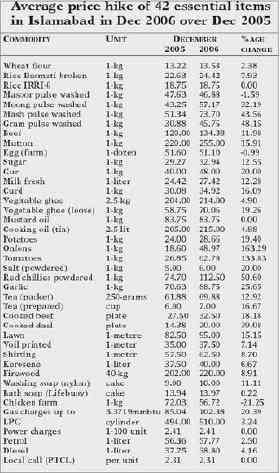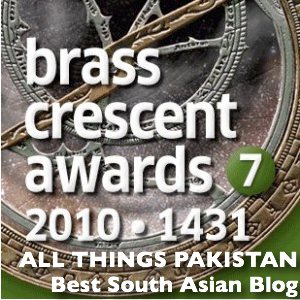 One of the great untold stories of 2006 may have been how economic existence for poor and middle class Pakistanis continued to become harder (here, here and here) even as a number of macroeconomic indicators seemed to do well. Some would say that eventually the benefits of macroeconomic growth will trickle down. But eventually can come too late for some.
One of the great untold stories of 2006 may have been how economic existence for poor and middle class Pakistanis continued to become harder (here, here and here) even as a number of macroeconomic indicators seemed to do well. Some would say that eventually the benefits of macroeconomic growth will trickle down. But eventually can come too late for some.
A survey conducted by Dawn in Islamabad reports that “the prices of 36 daily-use items witnessed an upward trend compared to last year [2006].” (click on image for larger view)
…the prices of pulses registered a phenomenal increase during December 2006 over the corresponding period last year. The prices of moong (washed) went up by 32 percent, mash (washed) 43 percent and gram (washed) by 48 percent. This increase was despite the government’s subsidies announced a few months back to stabilise the rates of the commodities in the market.
Among other items, the prices of onions and tomatoes increased by 163 percent and 133 percent, respectively. Prices of salt, red chillies and garlic also increased by 20 percent, 50 percent and 25 percent.
Energy prices were, of course, another major area that broke the back of the poor and middle class:
The prices of gas rose by 20 percent, petrol 2.5 percent and diesel 4.16 percent during December 2006 compared to the corresponding period last year. Ahsanullah, a lower division clerk, said his utility bill had increased from Rs300 to Rs2,000 � a good half of his whole salary.
As we wrap up the year 2006, looking back at how the prices of these essential commodities went up is sobering. These are commodities that everyone needs and the price hike demonstrates the burdens on the poor. ‘Inflation’ is the word that many have thought of but few have dared say in 2006. It may be a word that we will continue to whisper in 2006. Whether this is inflation or not can be debated, but it is still an indication of the economic challenges for the middle class.
Speaking of 2006, we are about to close our ATP Poll on the Impacts of 2006. The results till now are as follows (more detailed analysis later). If you have not voted yet, please do so.





















































Tandoori/Chapti Roti=Rs.3.00
Kulcha[till wali roti]=Rs.400
(Source Pathan bhai ka tanoor near home)
Poori[Halwa Poori wali]=Rs.4.00
(Source:Rizwan bhai ki puri ki dukaan)
Snice both daal and aata is getting out of hand, I think we have experienced Aata daal ka bhaoe :>
P.S: If you are in Karachi then do try Halwa puri at FB area water pump. I am sure you wouldn’t have experienced it before.
@Adnan: Have you checked Jodia Bazar rates?
By way of update, good news here:
Subhanallah
By way of update, the Daily Times reports (1 Jan. 07):